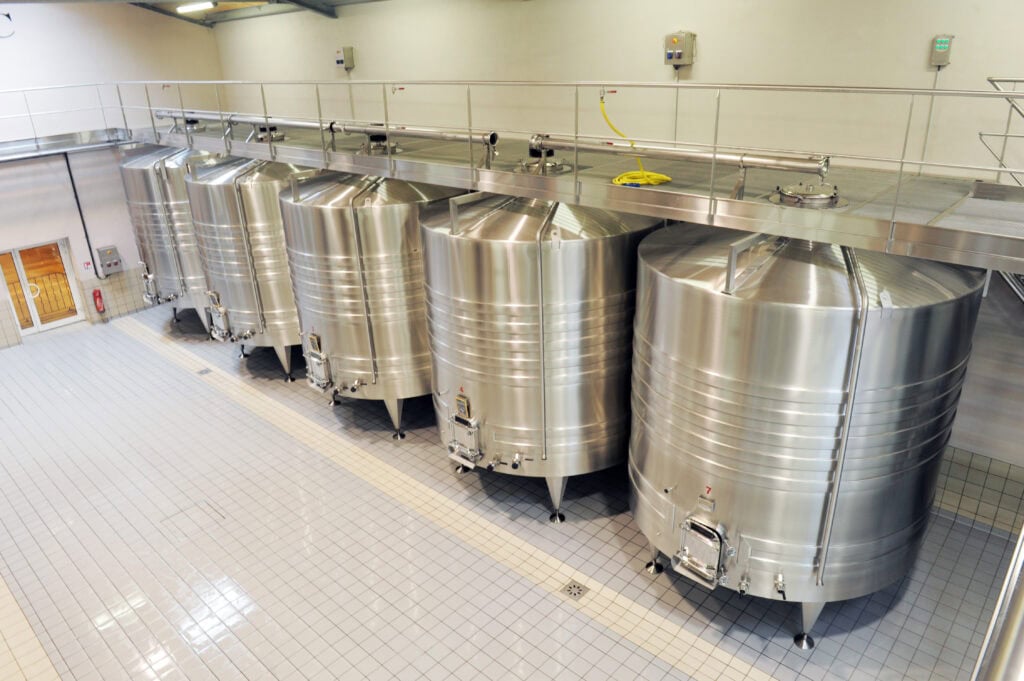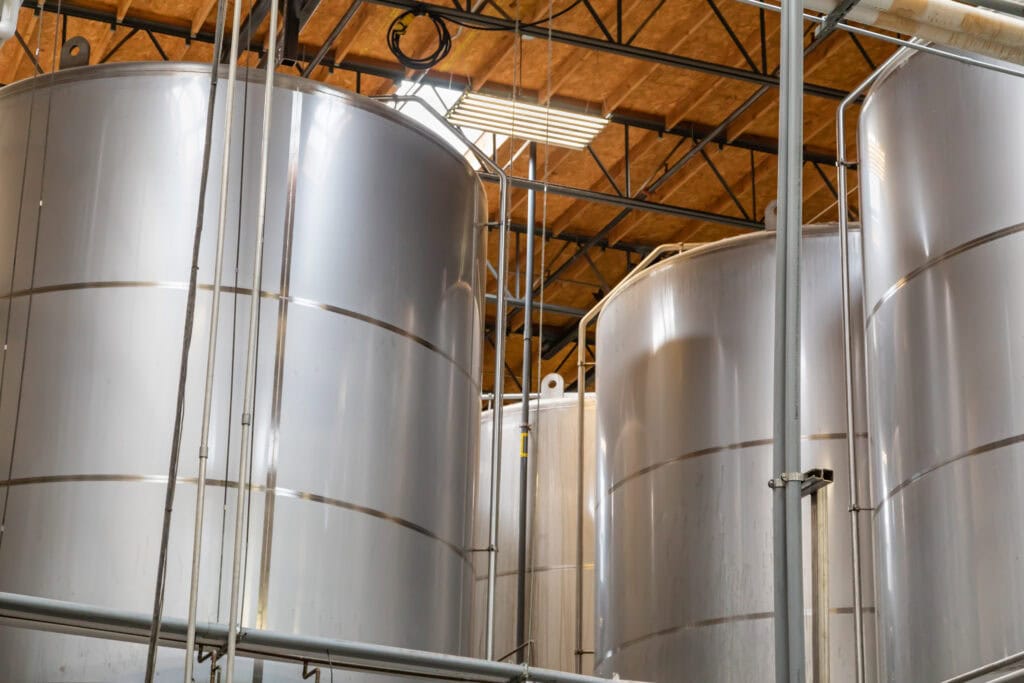One of the most common questions we hear from plant managers and engineers is:
“Should we go with carbon steel or stainless steel?”
And, truthfully, it’s a fair question.
Both materials have proven themselves in industrial applications, but choosing well depends on more than just budget. Make the wrong call, and you could be looking at unexpected repairs, compliance issues, or early equipment replacement.
At Schmidt Industrial Services, we’ve fabricated, repaired, and lined tanks for industries ranging from food production to chemical processing. Having seen the advantages (and the pitfalls) of both carbon steel and stainless steel in the field, we put this guide together to share what we have learned.
Here’s what you’ll find inside:
- A breakdown of carbon steel vs stainless steel properties
- How each material performs in real-world plant conditions
- Cost, maintenance, and compliance considerations for both options
- Practical tips to help you choose the right tank for your operation
By the end, you’ll have the clarity you need to make an informed, confident decision for your facility.
The Fundamentals: What’s the Real Difference?
You might hear a lot of engineers comparing tank material, but when they do that, they’re really trying to compare strength, corrosion resistance, and total lifecycle cost.
Carbon steel tanks are primarily composed of iron and carbon (typically under 2% carbon content). They’re strong, tough, and easy to weld, making them a favorite for large storage vessels, fuel systems, and pressure applications.
Thanks to being cost-effective and versatile, carbon steel represents more than 90% of the world’s steel production. However, it has one weakness: without protective coatings, carbon steel rusts quickly in moisture or chemical environments.
On the other hand, stainless steel tanks are made by alloying iron with chromium, nickel, and sometimes molybdenum. The key is the chromium content (usually above 10.5%). Thanks to this chromium content, a thin, invisible oxide layer forms on the surface.
This layer continuously “self-heals,” giving stainless steel its natural corrosion resistance. It’s why stainless is often chosen for chemical storage, food processing, and high-sanitation environments where failure is not an option.
In short, it’s not one over another. Both materials have earned their place in the industry. The difference lies in how they perform under your plant’s specific chemical, thermal, and operational demands.
In the following sections, we’ll show you exactly how those factors measure up.
Corrosion Resistance: The Real Cost Driver
Without a doubt, corrosion is the silent profit drain of industrial operations and the first thing to think about when choosing steel. Yes, even before the upfront cost.
Why?
The annual global cost of corrosion exceeds $2.5 trillion, with storage tanks accounting for a large share of that total.
Now you’re probably thinking stainless steel tanks are the winning choice here. After all, they naturally resist corrosion thanks to their chromium-oxide surface. This passive layer acts like a built-in shield against oxygen and moisture, even after minor scratches or abrasions.
And you’re not wrong, stainless steel is the go-to material in chemical and food-grade environments where contamination prevention and long-term reliability are critical.
On the other hand, carbon steel tanks can rely on protective systems like epoxy linings, rubberized coatings, or specialized paint systems to achieve similar performance. Even better? When done right, these coatings can dramatically extend lifespan.
At Schmidt, our industrial coatings division (ERS) uses high-build epoxy and phenolic linings that have proven to last up to ten times longer than standard coatings, giving carbon steel tanks stainless-like longevity at a fraction of the cost.
The takeaway?
While stainless steel offers inherent protection, carbon steel relies on design. The right coating system, when engineered and maintained correctly, can bring its performance remarkably close to stainless.
Durability and Maintenance in Real Plant Conditions
We’ve talked a lot about durability in relation to corrosion, but it’s essential to know that durability isn’t just about corrosion. It’s about how a tank performs under pressure, heat, repetitive use, and most of all…maintenance discipline.
When comparing the two, carbon steel is known for its impressive tensile strength and rigidity. It can handle high loads, making it ideal for pressurized applications or large-volume vessels. However, its durability is only as good as its protective coating system. If the coating fails, corrosion begins quickly, particularly around weld seams and nozzles.
In short, carbon can be highly durable…
By contrast, stainless steel tanks offer superior endurance against variable temperatures, repeated cleaning cycles, and chemical exposure.. Still, stainless isn’t maintenance-free; surface passivation and periodic cleaning are needed to prevent contamination or stress cracking, especially in chloride-rich environments.
In our field experience, a properly lined carbon steel tank that is maintained on schedule can easily outperform a neglected stainless tank. The difference almost always comes down to maintenance discipline, not metallurgy.
Cost Analysis: Upfront vs. Lifecycle
Cost is often the deciding factor in the carbon steel vs stainless steel debate, but as we mentioned initially, focusing solely on upfront price can be misleading.
Carbon steel typically costs 30-40% less than stainless steel in material price alone. It’s also faster and easier to fabricate, which reduces installation time and labor.
However, carbon steel’s actual cost comes from maintenance.
Without proper coatings and inspections, corrosion can force recoating or early replacement. Stainless steel has a higher initial price tag but minimal upkeep. Over 25 years, the total cost of ownership for stainless can actually be lower for operations that deal with aggressive chemicals or demanding sanitation cycles.
Compliance, Safety, and Industry Standards
Compliance often determines material choice as much as chemistry does. In chemical plants, both materials can meet ASME Section VIII pressure vessel requirements, but coated carbon steel must be monitored more closely to ensure long-term integrity.
In food and beverage applications, stainless steel tanks are usually the default. They meet FDA, NSF, and 3-A Sanitary Standards, offering seamless welds and polished finishes that prevent microbial buildup, for less sensitive applications (such as storage of oils, syrups, or wastewater), coated carbon steel remains a safe, economical option when paired with FDA-approved linings.
At Schmidt Industrial Services, all tanks are built to ASME U-Stamp and NBIC R-Stamp standards, ensuring that both carbon and stainless systems meet the highest safety and fabrication benchmarks.
Want to learn more about our fabrication process? Check out our Metal Fabrication Services.
Practical Factors to Consider Before Choosing
The choice between carbon steel tanks and stainless steel tanks depends on your specific plant conditions:
- Chemical Compatibility: Acids, brines, and chlorides demand stainless; neutral or non-corrosive products may perform well in coated carbon steel.
- Cleaning Requirements: Frequent CIP (clean-in-place) or sterilization cycles lean toward stainless due to easier sanitation.
- Location and Climate: Outdoor installations or marine exposure increase corrosion risk, favoring stainless steel.
- Maintenance Capabilities: Facilities with structured inspection programs can safely operate carbon steel tanks for decades.
For plants balancing tight budgets with long-term reliability, engineers can often recommend hybrid approaches, carbon steel fabrication with specialized epoxy or rubber linings for specific zones of chemical exposure.
The Schmidt Perspective on Steel Tanks
For over 75 years, Schmidt Industrial Services has helped industrial clients make these material decisions with confidence. We’ve built and repaired both carbon steel and stainless steel tanks for industries spanning energy, food, and chemical.
That experience means we don’t rely on theory; we’ve seen how each material performs in the field. Whether you need a pressure-rated vessel for a refinery or a sanitary mixing tank for food processing, our team can help you evaluate corrosion risk, lifecycle cost, and regulatory compliance before fabrication begins.
Explore our full range of services at Schmidt Industrial Services.
FAQs
Are there other materials I should consider besides steel?
Yes, there are other materials for tanks to consider aside from steel. While most industrial facilities rely on carbon steel or stainless steel, certain operations benefit from fiberglass tanks or lined steel hybrids. Fiberglass tanks offer solid corrosion resistance for non-pressurized storage but lack the durability and structural strength of metal tanks under high pressure or temperature.
How do I make sure my tanks last as long as possible?
The secret to a long lifespan isn’t just the tank material; it’s maintenance and coating quality. Even stainless steel can fail if welds aren’t properly finished or if it’s exposed to chloride-rich cleaners. Meanwhile, carbon steel tanks can last for decades when properly coated and inspected.
Can stainless steel ever corrode?
Yes, stainless steel can corrode, and it happens more often than people think. While stainless steel is known for its excellent corrosion resistance, it’s not immune. Under the right (or wrong) conditions (such as constant exposure to chlorides, high humidity, or acidic cleaning agents), even the best stainless steel tanks can develop pitting corrosion or surface staining.
The good news? With the right design, polishing, and maintenance practices, stainless steel can easily achieve a long lifespan and outstanding durability. Our fabrication team ensures every weld and surface meets the highest quality standards, reducing corrosion risk from the start.
The Bottom Line: Material Choice Is About Context
When it comes to carbon steel vs. stainless steel, the right choice isn’t universal; it’s the one that best fits your operation. If you’re storing or processing corrosive materials, or if compliance and hygiene are paramount, stainless steel delivers peace of mind through built-in corrosion resistance.
But if your process involves non-corrosive media, controlled environments, or budget-sensitive expansion, carbon steel tanks with the right coatings offer unmatched value. In both cases, success depends less on the alloy itself and more on engineering, fabrication quality, and maintenance discipline.
At Schmidt, we engineer tanks that don’t just meet specifications; they stand the test of time. Because the right material is only half the story, the other half is experience.


